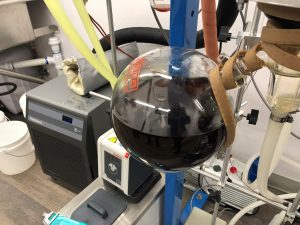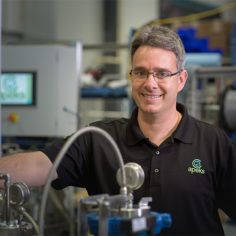
Editor’s note: This is the latest in a series about myths in the cannabis industry. Read about common cultivation myths here and common lighting myths here.
Cannabis extractors operate with scarce scientific resources or standards to consult, and much of their knowhow is gained via word-of-mouth or from other industries.
Manufacturers on all levels of the THC spectrum have had to adapt techniques from food, pharmaceutical and even perfume companies to bring extracted cannabinoids to market.
“There was a lot of misleading information years and years ago, when we were all self-taught and the internet wasn’t as robust,” said Nate Ferguson, co-founder of Jetty Extracts in Oakland, California. “You had to figure it out for yourself, and other extractors always liked to lead you down the wrong path because they would get so competitive.”
So it comes as no surprise that some cannabis processing methods are grounded more in habit than fact. We caught up with some extraction experts to get their takes on the most persistent processing myths in cannabis – plus their takes on new technology that may not be ready for prime time.

Tiffany Coleman
MYTH 1: Stems + hot alcohol = hash.
There are still people out there trying to make hash using marijuana stems and hot isopropyl alcohol. Let us just put all that down to say they will fail.
Hash was originally made using mechanical separation of the trichomes (rolling in hands, beating with sticks, shaking in bags, etc.) not by boiling sticks in isopropyl alcohol. I still don’t know why people think this will work – there’s hardly any THC in stems to begin with. Such is life.
-Tiffany Coleman, founder, Cassin Consulting, Lansing, Michigan

Jorge Sanchez
MYTH 2: Baking sorbents helps.
(editor’s note: sorbents are materials used to absorb or adsorb liquids or gases)
They do this to remove water that is adsorbed in them, because they believe the water prevents the chlorophyll from being able to attach to the sorbents’ surface.
What the water is actually doing is degumming the oil and improving its overall clarity by hydrating the hydratable phospholipids to allow them to further break down and be easily removed by the sorbents. When they bake them, they are driving their bleaching process in a negative direction. These sorbents are loaded with a specific moisture content by the manufacturer for a good reason.
– Jorge Sanchez, co-founder of ChemTek, San Diego

Alex Goff
MYTH 3: Ethanol crude is winterized oil.
I have heard this term a lot, and generally winterized oil has gone through a winterization step, but cold ethanol crude never has to be winterized since it never extracts the waxes.
-Alex Goff, COO, Gemini Extraction, Erie, Colorado
MYTH 4: You can’t get pesticides out of concentrates.
There is a myth that you cannot remove heavy metals or pesticides from concentrates. The truth is, anything is possible given the appropriate solvents with liquid-to-liquid extraction or by utilizing activated filters, like activated carbon and running your tincture through this. That’s how they do it in lots of places.
And I’m convinced that people who have been doing it the old-school way ¬– who winterized using micron filters and activated carbon – were doing this without even knowing that was the purpose. Sure, it also helps pull out color and trap lipids, but it does so much more as well.
-Tiffany Coleman
MYTH 5: Leftover ethanol concentrates are unsafe.
When it comes to ethanol and hydrocarbon extraction, there’s often a fear of leftover solvent (ethanol or butane) in the finished product. People are concerned that it’s unsafe, even from facilities that take precautions.
The way these are purged – with the solvents placed under heat and vacuum agitation – after a given amount of time, the traces detected are well below the required threshold of parts per million.
Although there are trace amounts of alcohol in many things we encounter in everyday life, there are far less in extracts that have been exposed to heat and vacuum procedures.
These leftover concentrates are safe and validated by the vigorous quality-assurance testing done before the release of these products.
– Adam Chambers, sales representative, Prospiant, San Francisco

Andy Joseph
NOT READY FOR PRIME TIME: Ultrasonic-assisted extraction.
The idea is to apply ultrasonic energy to the plant material while being extracted with a solvent (it doesn’t matter what the solvent is). The ultrasonic energy is theorized to enhance the extraction by vibrating the plant matter, allowing the solvent to penetrate faster and/or remove more oil for a more complete extraction.
While the method has been proven to be feasible, all of the tests are on a small scale. Utilizing it at a scale needed for marijuana or hemp is impractical if not impossible.
-Andy Joseph, founder, Apeks Supercritical (now Prospiant), Youngstown, Ohio
We do ultrasonic (extraction), but we only do it at small scale. … It’s not our workhorse, and essentially it’s a way we can be a little more efficient in our processes. It increases efficiency, absolutely … (but) I haven’t been approached to buy any large-scale ultrasonic equipment.
-Nate Ferguson

Hunter Neubauer
NOT READY FOR PRIME TIME: Color remediation columns.
People think you can run inferior product through a CRC (color-remediation column) and it will be more appealing to the consumer. But at the end of the day, the product is not better.
We don’t do it, and that becomes something you can sell against. We’re not trying to hide old material by using CRC.
-Hunter Neubauer, CEO, Oregrown, Bend, Oregon
Check out strategies and tips from expert extractors around the country in our free report, “Innovation in Cannabis Extraction,” available here. .
Kristen Nichols can be reached at [email protected]

